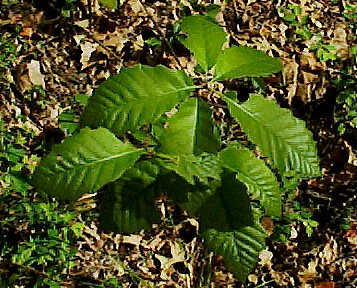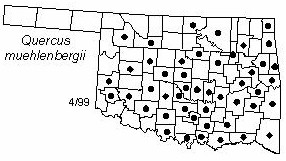
Medium-sized tree to 25 m (80 ft) tall and 50 cm (18 in) in diameter. Twigs slender, glabrous, gray, ending in a cluster of light brown glabrous buds. Bark thin, light gray, scaly or flaky. Leaves 10-15 cm (4-6 in) long and 4-7 cm (1.6-2.8 in) wide, obovate or elliptical, tapering to base, numerous side veins ending in a curved tooth on wavy edges, whitish-green below and shiny-glabrous above. Acorns 15-25 mm (0.6-1 in) long, egg-shaped, maturing in the first year.
Distribution: The species is native to most of the eastern U. S. except in coastal areas. A disjunct population is found in the mountains of far western Texas.
Habitat in Oklahoma: oak-hickory and Cross Timbers, especially on or near limestone.
NWI status: FAC
Comment: Quercus is the ancient classical name for the European oaks; muehlenbergii honors G. H. E. Muehlenberg, minister and botanist in Pennsylvania.
Distribution in Oklahoma: 
BACK
NEXT
RETURN TO INDEX
Last update: 9/17/99
 Go to Oklahoma Biological Survey Home Page
Go to Oklahoma Biological Survey Home Page
 Disclaimer
Disclaimer